American Identities: A New Look
1 of 11
This major installation of more than three hundred fifty objects from our premier collection of American art integrates a vast array of fine and decorative arts (silver, furniture, ceramics, and textiles) ranging in date from the colonial period to the present. For the first time, major objects from these exceptional collections are joined by selections from our important holdings of Native American and Spanish colonial art.
The galleries are organized according to eight innovative themes: From Colony to Nation; A Nation Divided: The Civil War Era; The Centennial Era, 1876–1900: Tradition and Innovation; Everyday Life; Expanding Horizons; Inventing American Landscape; Making Art; and Modern Life (see highlights at left). Through these themes you can explore historical moments and crucial ideas in American visual culture over the course of nearly three hundred years. Featured within these sections are American masterworks for which these collections have long been known, by such artists and makers as John Singleton Copley, Thomas Cole, Albert Bierstadt, Herter Brothers, Union Porcelain Works, Thomas Eakins, John Singer Sargent, Augustus Saint-Gaudens, Frank Lloyd Wright, Marsden Hartley, Georgia O’Keeffe, William Edmondson, David Smith, Richard Diebenkorn, and Robert Colescott.
Organizing department
American Art
Media
See more images of the Brooklyn Bridge and read about its history.











